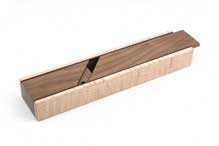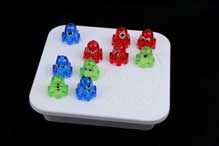2010 Puzzle Design
Competition
|
|
2010 Puzzle Design
Competition
|
|
The Design Competition Guide (photos, instructions, and relevant notes) is available here. |
The following is a summary of the 62 entries in the 2010 competition (click on images for larger photos).
All designs are copyrighted and are the intellectual property of the designer. All rights are reserved.
|
Designer: Kagen Schaefer Materials: Walnut, maple, wenge hardwoods Purchase: To be produced Fall 2010. Price is $200. Contact the designer by . |
 |
|
Designer: Stephen Chin Materials: Exotic woods History: Inspired by Wayne Daniel's 10-piece Icosahedrons. Purchase: Limited number made $300. Contact the designer by . |
 |
|
Designer: Donghoon Pee Materials: EVA (ethylene vinyl acetate copolymer) |
 |
|
Designer: Tom Lee Materials: Stainless steel 3.5mm wire, gold-plated ring, rope Purchase: Price $8 (handmade). Contact the designer by . |
 |
|
Designer: Hidetoshi Takeji Materials: ABS plastics, polyurethane resin History: This idea comes from Rubik's Domino and the Bump Cube (Takeji), using height differences instead of pips and black/white colors. |
 |
|
Designer: Osanori Yamamoto Materials: Wood Purchase: Contact the designer by . |
 |
|
Designer: Hiroshi Kaneko Materials: Birch, satinwood, walnut Purchase: Contact the designer by . |
 |
|
Materials: Oak, walnut, karin, camphor, rose wood |
 |
|
Designer: Allan Stein Materials: Walnut, maple, bolt and nut Notes: This puzzle is like a piece on a pie chart. This shows that many of us want a "piece of the pie" in life. Solving the puzzle allows a coin to come out, which is a "piece of the pie" in life. Purchase: See PuzzleMaster.ca or contact the designer by . |
 |
|
Designer: Matthew Dawson Materials: Wood, etc. Purchase: 18 made for sale in fancier woods, and 14 exchange versions available while supply lasts as: puzzleparadise.ca. |
 |
|
Designer: Yoko Kakuda Materials: Burs wood, karin |
 |
|
Designer: Osanori Yamamoto Materials: Wood Purchase: Contact the designer by . |
 |
|
Designer: Vinco Obsivac Materials: Plum-tree and maple Purchase: Price: 60€. See vinco.cz or contact the designer by . |
 |
|
Designer: Iwahiro (Hirokazu Iwasawa) Materials: Polarizing plates |
 |
|
Designer: Tomas Lindén, Vesa Timonen Materials: Birch and heat treated birch. Purchase: See sloyd.fi. |
 |
|
Designer: Jared McComb Materials: ABS plastics, polyurethane resin History: Based on Rubik's Domino and the Bump Cube (Takeji). |
 |
|
Designer: George Miller Materials: Polychromatic acrylic and EVA |
 |
|
Designer: Raf Peeters
Materials: ABS plastic Purchase: This is a mass produced puzzle that is sold worldwide under the brand SmartGames. |
 |
|
Materials: Metal Purchase: This is a mass produced puzzle made by Hanayama. |
 |
|
Designer: Pantazis Houlis Materials: Metal rods, plastic tubes, rubber tubes |
 |
|
Designer: Tom van der Zanden Materials: Nylon (selective laser sintering), self-adhesive vinyl History: Inspired by the Bevel Cube (Okamoto) and Helicopter Cube (Cowan). By angling the cuts of the Bevel/Helicopter Cube, the otherwise hidden edge pieces were made visible. The visibility of these parts makes the puzzle much more difficult to solve. The angled cuts create a face pattern with beautiful curves, from which the puzzle gets its name. Purchase: Finished puzzles available from the designer at www.tomvanderzanden.nl or for 160€+shipping. DIY kits available from the designer's Shapeways shop for 140€ (shipping included, add 19% VAT for EU customers). |
 |
|
Designer: Kohfuh Satoh Materials: Wooden stick, waxed string, paper envelope |
 |
|
Designer: Lee Krasnow Materials: assorted exotic hardwoods, steel dowel pins History: Based on Stewart Coffin's "Pennydoodle" puzzle, this set of 12 pieces (four of which are duplicates) was chosen based on BurrTools analysis. |
 |
|
Materials: Acrylic board Purchase: Contact the designer by . |
 |
|
Designer: Namick Salakhov Materials: Plexiglas Purchase: Contact the designer by . |
 |
|
Materials: brass Purchase: See puzzle.palyn.ru or contact the designer by . |
 |
|
Designer: Albert Gübeli Materials: PVC 4 mm Purchase: Price: $60, from designer by or at shapeways.com. |
 |
|
Materials: Brazilian purple wood, birch History: This design pays homage to Nob Yoshigahara's Dualock Puzzle, but any similarity is only visual. |
 |
|
Designer: Kyoko Hoshino Materials: walnut, shiuri cherry, wenge, cloth |
 |
|
Designer: Katsuhiko Okamoto Materials: ABS resin, POM History: Outside puzzle (OP) is the Void Cube. Inside puzzle (IP) is the apex turning octahedron. OP and IP are connected only by three places (marked by the stars). OP and IP synchronized rotate when the star mark is included in the rotation face. When the star mark is not included, OP and IP can respectively be rotated alone. |
 |
|
Designer: Katsuhiko Okamoto Materials: ABS resin Notes: Edge parts rotate only in the direction of the arrow. White arrows are clockwise and black arrows are counterclockwise. You cannot turn a face with both a white and black arrow. |
 |
|
Designer: Robert Yarger Materials: Maple, purpleheart, leopardwood, walnut and padauk |
 |
|
Designer: Mustafa Kürsat AY Materials: Magnets and ABS plastic Notes: The mechanism is an improvement of the original Nichols' Cube. Purchase: Price: 20€. Contact the designer by . |
 |
|
Designer: Frank Potts Materials: Western Australian jarrah, aluminum, polycarbonate |
 |
|
Designer: Kim Klobucher Materials: Various hardwoods and brass inlay Notes: Six produced so far; $450. See kcubedesigns.com or contact the designer by . Purchase: Six produced so far; $450. See kcubedesigns.com or contact the designer by . |
 |
|
Materials: Karin, magnolia, keyaki (zelkova) |
 |
|
Designer: Gregory Benedetti Materials: Maple for the frame; dark oak and maple for the pieces Purchase: There was only a small batch of 25 pieces produced. See puzzlewood.de or contact B. Schweitzer by . |
 |
|
Designer: Kohno Ichiro Materials: Lauan, magnet, acrylic Purchase: Contact the designer by . |
 |
|
Designer: Teddy Sakamoto Materials: ABS Purchase: This puzzle will be sold by Hanayama as "GariGari Ice Bar Puzzle". |
 |
|
Designer: Pantazis Houlis, Arcady Dyskin, Alexei Kanel-Belov, Elena Pasternak, Juri Estrin Materials: Different color types of timber wood |
 |
|
Designer: Bram Cohen Materials: Wood History: Inspired by concepts from Andreas Rover's CM13 puzzle and the 4-Piece Jigsaw puzzle. Purchase: See jerrymcfarland.com. |
 |
|
Designer: Jeremy Goode Materials: Acrylic box, GPPS internals, steel ball Purchase: Price: £20. See xmatrix.co.uk. |
 |
|
Designer: Kelvin Stott Materials: Injection-molded transparent ABS blocks, polyurethane domed metallic-effect labels. Notes: Each individual puzzle is unique, with its own solution. |
 |
|
Designer: Robrecht Louage Materials: Trespa Purchase: Contact the designer by . |
 |
|
Designer: Tim Snyder Materials: Padauk, red oak, purple heart, yellow heart, steel balls and neodymium magnets History: Inspired by John Harris' Rolling Cube Puzzle. Purchase: Only two made; contact the designer by . |
 |
|
Designer: Hideaki Kawashima Materials: Shuri cherry, maple, walnut, magnolia |
 |
|
Designer: George Bell Materials: Nylon (selective laser sintering 3D printing) Notes: Both puzzles consist of three helical pieces plus one odd piece. Two of the helical pieces are identical and the third is their mirror image. Purchase: Smaller copies of the Octahedron are available at shapeways.com. |
 |
|
Designer: Perry McDaniel Materials: Curly koa, mahogany, ebony, poplar, walnut, bloodwood, cherry, pink ivory, maple Purchase: Limited Edition of 100 to be produced. Contact the designer by . |
 |
|
Designer: Tony Fisher Movements possible include 3 layers (disks) of rotation plus a single vertical 'slide' in one direction only. Materials: 3 Standard IQ139 Puck Puzzles, polyurethane resin, clear acrylic Notes: When scrambled many of the numbers will no longer be directly viewable. In addition it will not be known if they actually have numbers or are blank. |
 |
|
Designer: Yuta Akira Materials: Chrome plated iron nail |
 |
|
Designer: Tom Lee Materials: Stainless steel 3.5mm wire, gold-plated ring, rope and wooden bead Purchase: Price $50 (handmade). Contact the designer by . |
 |
|
Designer: Yoshiyuki Ninomiya Materials: Chanchin, laquer tree, yosegi, etc. |
 |
|
Designer: Hendrik Haak Materials: Original padlock, glass Purchase: There may be a small limited production; contact the designer by . |
 |
|
Designer: Albert Gübeli Materials: ABS, 3D print Purchase: Price $40. Contact designer by , or at shapeways.com. |
 |
|
Designer: Goh Pit Khiam Materials: Papua New Guinean rosewood History: Inspired by Bill Cutler's Binary Burr, and Marcus Götz's Crazy Elephant Dance. |
 |
|
Designer: Hideaki Kawashima Materials: Rose wood, shiuri cherry, maple |
 |
|
Designer: Hiroshi Iwahara Materials: Walnut, ichii, magnolia, dogwood, birch |
 |
|
Designer: Diniar Namdarian A "snake movement" is a movement where at least one cube of the snake remains in the same position (without rotation) and the rest of the snake is lifted, rearranged and placed flat in the tray in a new position. Materials: Wood Purchase: Puzzle cost: $25. Contact the designer by . |
 |
|
Designer: Raf Peeters Materials: ABS plastic Purchase: This is a mass produced puzzle that is sold worldwide under the brand SmartGames. |
 |
|
Designer: Hiroshi Kaneko Materials: Maple Purchase: Contact the designer by . |
 |
|
Designer: Sjaak Griffioen
Materials: Plastic History: This design adds a new rule to the classic Skyscraper pencil puzzle. Purchase: Price: $19.99. See popularplaythings.com. |
 |
|
Designer: Louis Toorenburg Materials: Pine with labels Purchase: See nzanity.co.nz or contact the designer by . |
 |
| © 2001-2010 by |